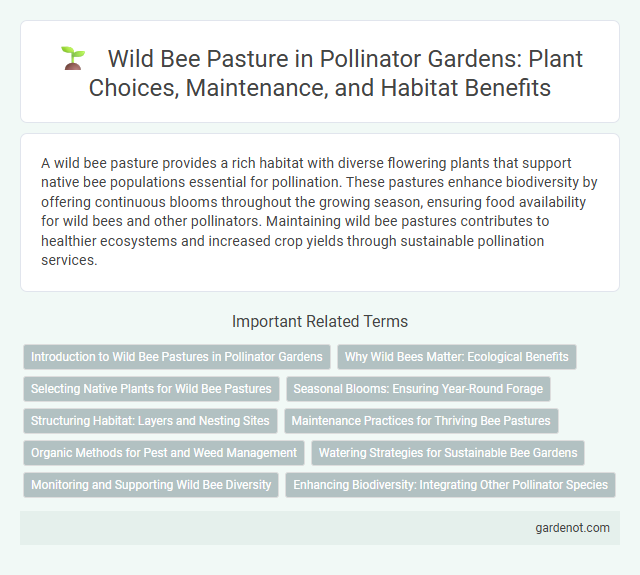A wild bee pasture provides a rich habitat with diverse flowering plants that support native bee populations essential for pollination. These pastures enhance biodiversity by offering continuous blooms throughout the growing season, ensuring food availability for wild bees and other pollinators. Maintaining wild bee pastures contributes to healthier ecosystems and increased crop yields through sustainable pollination services.
Introduction to Wild Bee Pastures in Pollinator Gardens
Wild bee pastures in pollinator gardens consist of diverse native flowering plants that provide essential nectar and pollen resources for wild bee species throughout their active seasons. These habitats support vital ecosystem services by enhancing pollination efficiency and increasing biodiversity within urban and rural landscapes. Establishing wild bee pastures helps sustain populations of solitary and ground-nesting bees, which are crucial for the health of both wild flora and agricultural crops.
Why Wild Bees Matter: Ecological Benefits
Wild bee pastures provide essential habitats that support pollination services critical for biodiversity and crop production. These areas enhance ecosystem resilience by improving plant reproduction and maintaining genetic diversity in wild flora. Protecting wild bee populations contributes to soil health, pest control, and overall ecosystem stability, making them vital for sustainable agriculture and natural habitats.
Selecting Native Plants for Wild Bee Pastures
Selecting native plants for wild bee pastures enhances pollinator support by providing habitat-specific nectar and pollen sources critical for native wild bee species. Native wildflowers such as coneflowers, milkweed, and goldenrod offer extended bloom periods that align with the life cycles of local bees, promoting biodiversity and ecosystem stability. Incorporating native grasses like little bluestem alongside flowering plants further supports nesting and foraging needs, creating a resilient and thriving pollinator garden.
Seasonal Blooms: Ensuring Year-Round Forage
Wild bee pastures featuring diverse native wildflowers provide essential seasonal blooms that support pollinators throughout the year. Early spring blossoms like willow and crocus offer vital nectar sources, while summer-flowering species such as coneflowers and goldenrods maintain consistent forage. Late-season blooms, including asters and sedums, extend foraging opportunities, promoting wild bee health and enhancing overall pollinator garden productivity.
Structuring Habitat: Layers and Nesting Sites
Wild bee pastures enhance pollinator gardens by providing diverse floral layers that mimic natural habitats, supporting various bee species throughout their life cycles. Incorporating ground nesting sites, bare soil patches, and hollow stems within these layers creates essential nesting opportunities for solitary and ground-nesting bees. Structured habitats with vertical diversity and nesting resources increase wild bee populations, promoting effective pollination and ecosystem resilience.
Maintenance Practices for Thriving Bee Pastures
Maintaining a wild bee pasture requires regular monitoring of flowering plant diversity to ensure continuous nectar and pollen availability throughout the growing season. Implementing rotational mowing schedules prevents overgrowth while allowing native wildflowers to bloom and support diverse bee populations. Controlling invasive species through selective weeding promotes a healthy habitat that favors wild bees' nesting and foraging needs, enhancing overall pollinator health.
Organic Methods for Pest and Weed Management
Wild bee pastures benefit from organic methods for pest and weed management that avoid harmful chemicals, promoting a healthier ecosystem for pollinators. Techniques such as crop rotation, mulching with organic materials, and introducing beneficial insects naturally control pests and suppress weeds without disrupting wild bee habitats. Maintaining diverse native plant species further supports wild bees by providing continuous forage while reducing the need for synthetic herbicides and pesticides.
Watering Strategies for Sustainable Bee Gardens
Wild bee pastures thrive through targeted watering strategies that maintain soil moisture without oversaturation, supporting native plant health and providing essential hydration for pollinators. Drip irrigation and mulching reduce water waste and promote deep root growth, ensuring flowers bloom consistently to attract diverse bee species. Sustainable watering practices preserve the delicate balance of the ecosystem while enhancing the habitat's resilience against drought and climate fluctuations.
Monitoring and Supporting Wild Bee Diversity
Monitoring wild bee populations in a pollinator garden requires systematic surveys using pan traps and netting techniques to accurately assess species diversity and abundance. Supporting wild bee diversity involves planting a variety of native flowering plants that bloom sequentially throughout the growing season, providing continuous foraging resources. Creating nesting habitats such as bare soil patches and dead wood structures enhances reproductive success and encourages stable wild bee communities.
Enhancing Biodiversity: Integrating Other Pollinator Species
Wild bee pastures foster biodiversity by creating habitats that support a variety of pollinator species such as butterflies, hoverflies, and solitary bees. Incorporating diverse native flowering plants ensures continuous nectar and pollen sources throughout the seasons, promoting pollinator health and ecosystem resilience. This integration strengthens pollination networks, benefiting agricultural productivity and wild plant reproduction.
Wild bee pasture Infographic

 gardenot.com
gardenot.com